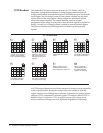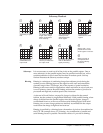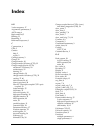
38 Advanced Camera Operation Manual
Spectral Response
Light normally enters the CCD through the gates of the parallel register. These
gates are made of very thin polysilicon that is reasonably transparent at long
wavelengths but becomes opaque at wavelengths shorter than 400 nm. Thus, at
short wavelengths the gate structure attenuates incoming light.
Thinning With acid etching techniques, CCDs can be uniformly thinned to approximately
10 µm, and an image can be focused on the backside of the parallel register
where there is no gate structure. These thinned, or backside-illuminated, CCDs
exhibit high sensitivity to photons from the soft x-ray to the near-infrared
regions of the spectrum. Thick and Thinned CCDs illustrates the structures of both
kinds of device.
Thick and Thinned CCDs
Incoming light
Polysilicon gate
Silicon dioxide
Silicon Thinned silicon
Incoming light
Down Converters CCD spectral response can also be extended with the use of a light-emitting
phosphor called a down converter. A down converter absorbs light in the
ultraviolet range of the spectrum and re-emits it in the visible range.
A CCD with a Down Converter demonstrates the use of the phosphor down
converter Metachrome
®
II in conjunction with a front-illuminated CCD.
A CCD with a Down Converter
120-450 nm light
Polysilicon gate
Silicon dioxide
Epitaxial silicon
Bulk silicon
400-1000 nm light
Phosphor
560 nm emission
The phosphor absorbs photons with short wavelengths and emits photons with
a 560 nm wavelength. These photons pass through the polysilicon gates into the
photon-sensitive region of the CCD. The down converter is transparent between
400 and 1000 nm, so CCD performance is not affected at these longer
wavelengths.
Down converters exhibit very high quantum efficiency and, when properly
processed and applied to CCDs, can produce a significant improvement in UV
sensitivity.


















